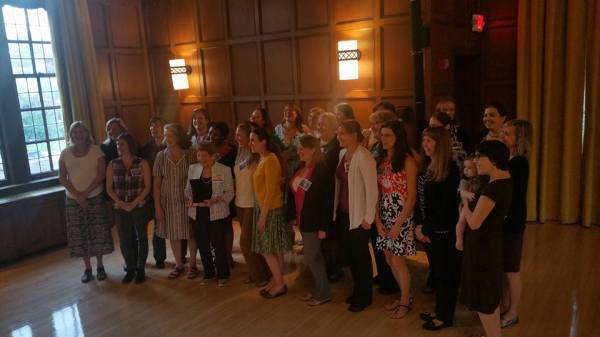The AAS Committee on the Status of Women in Astronomy maintains this blog to disseminate information relevant to astronomers who identify as women and share the perspectives of astronomers from varied backgrounds. If you have an idea for a blog post or topic, please submit a short pitch (less than 300 words). The views expressed on this site are not necessarily the views of the CSWA, the AAS, its Board of Trustees, or its membership.
Friday, September 30, 2016
AASWomen Newsletter for September 30, 2016
Tuesday, September 27, 2016
Career Profile: Astronomer to STEM Program Evaluator
Friday, September 23, 2016
AASWOMEN Newsletter for September 23, 2016
Issue of September 23, 2016
eds: Nicolle Zellner, Elysse Voyer, Heather Flewelling, Cristina Thomas, and Maria Patterson
This week's issues:
2. Help SGMA Assess Institutional Gender Identity and Expression Policies
3. A New Graduate School Policy on Parental Accommodation from Northwestern University
4. Cards Against Humanity Scholarship Seeks to Send Women in STEM to College
5. How Neil DeGrasse Tyson Champions Women & Geeks In 'StarTalk' Season 3
6. Study shows unexpected path for women to major in science
8. How to Submit to the AASWOMEN newsletter
9. How to Subscribe or Unsubscribe to the AASWOMEN newsletter
Wednesday, September 21, 2016
Help SGMA Assess Institutional Gender Identity and Expression Policies
At the American Astronomical Society (AAS) Diversity Summit last fall, its Committee for Sexual-Orientation and Gender Minorities in Astronomy (SGMA) decided to take on the project of improving institutional policies regarding gender identity and expression across the field of astronomy. We are starting that project with a request to readers of the Women in Astronomy blog to let us know the policies at their institution. I have set up a web survey to accept your answers. No personal information will be recorded.
Monday, September 19, 2016
"First" Impressions
Friday, September 16, 2016
AASWomen Newsletter for September 16, 2016
AAS Committee on the Status of Women
eds: Nicolle Zellner, Elysse Voyer, Heather Flewelling, Cristina Thomas, and Maria Patterson
This week's issues:
2. Sexual Harassment in the Sciences: A Call to Respond
3. University of California President’s Postdoctoral Fellowship Program
4. The Science Ambassador Scholarship
5. White House women want to be in the room where it happens
6. The Lenny Interview: Margaret Wertheim
7. How to Submit to the AASWomen Newsletter
8. How to Subscribe or Unsubscribe to the AASWomen Newsletter
9. Access to Past Issues of the AASWomen Newsletter
Tuesday, September 13, 2016
Women on Spacecraft Missions: Are we moving towards parity with the percentage in the field?
The following blog post was written by Dr. Julie Rathbun, Senior Scientist at the Planetary Science Institute and Professor of Physics at the University of Redlands. The post was originally posted at the Women in Planetary Science blog, and is cross-posted here.

Friday, September 9, 2016
AASWomen Newsletter for September 09, 2016
Issue of September 09, 2016
eds: Nicolle Zellner, Elysse Voyer, Heather Flewelling, Cristina Thomas, and Maria Patterson
This week's issues:
1. CSWA Chair = NASA Deputy Program Scientist for OSIRIS-REx = LAUNCH TODAY!
2. The Gender Factor in Conference Presentations
3. Female Scientists Turn to Data to Fight Lack of Representation on Panels
4. Do women in STEM careers suffer a ‘marriage market’ penalty?
5. On Being a Black Female Math Whiz During the Space Race
7. How to Submit to the AASWomen Newsletter
8. How to Subscribe or Unsubscribe to the AASWomen Newsletter
Thursday, September 8, 2016
CSWA Chair = NASA Deputy Program Scientist for OSIRIS-REx = LAUNCH TODAY!
Christina Richey, chair of the CSWA, is participating today in the launch of NASA's OSIRIS-REx Mission as deputy program scientist at NASA Headquarters. OSIRIS-REx will journey to the carbonaceous asteroid Bennu to collect surface samples that may trace the earliest composition of our Solar System, including water and organic molecules. The mission will also map Bennu's surface and test the Yarkovsky effect. The launch is garnering lots of public interest as one of what could be a number of asteroid sampling and surveying missions supported by NASA.
 |
| Deputy Program Scientist for ORSIRIS-REx at NASA Headquarters Christina Richey speaks during a briefing on NASA's Origins, Spectral Interpretation, Resource Identification, Security-Regolith Explorer (OSIRIS-REx) mission, Wednesday, Aug. 17, 2016 at NASA Headquarters in Washington. OSIRIS-REx is scheduled to launch on Sept. 8 from Cape Canaveral Air Force Station in Florida. Photo Credit: (NASA/Joel Kowsky) |
In this photo, Christina is showing a 3d model of Bennu; instructions on how to print one yourself are available to all. If you are curious about other scientists working on the mission, also check out this CSWA career profile of Harold C. Connolly Jr, a mission scientist for OSIRIS-REx.
You (and your friends) can watch the launch live today on NASA TV beginning at 5:30pm ET -- the actual launch is planned for 7:05pm ET.
Rock on, Christina!!
Friday, September 2, 2016
AASWomen Newsletter for September 02, 2016
Issue of September 02, 2016
eds: Nicolle Zellner, Elysse Voyer, Heather Flewelling, Cristina Thomas, and Maria Patterson
This week's issues:
1. Career Profile: Astronomer to Analytics Company Founder and Chief Scientist
2. Obama Lauds The Trailblazers On Women’s Equality Day
4. Scientists Support Young Girl Teased for Her Interest in Bugs With #BugsR4Girls
7. How to Submit to the AASWomen Newsletter
8. How to Subscribe or Unsubscribe to the AASWomen Newsletter